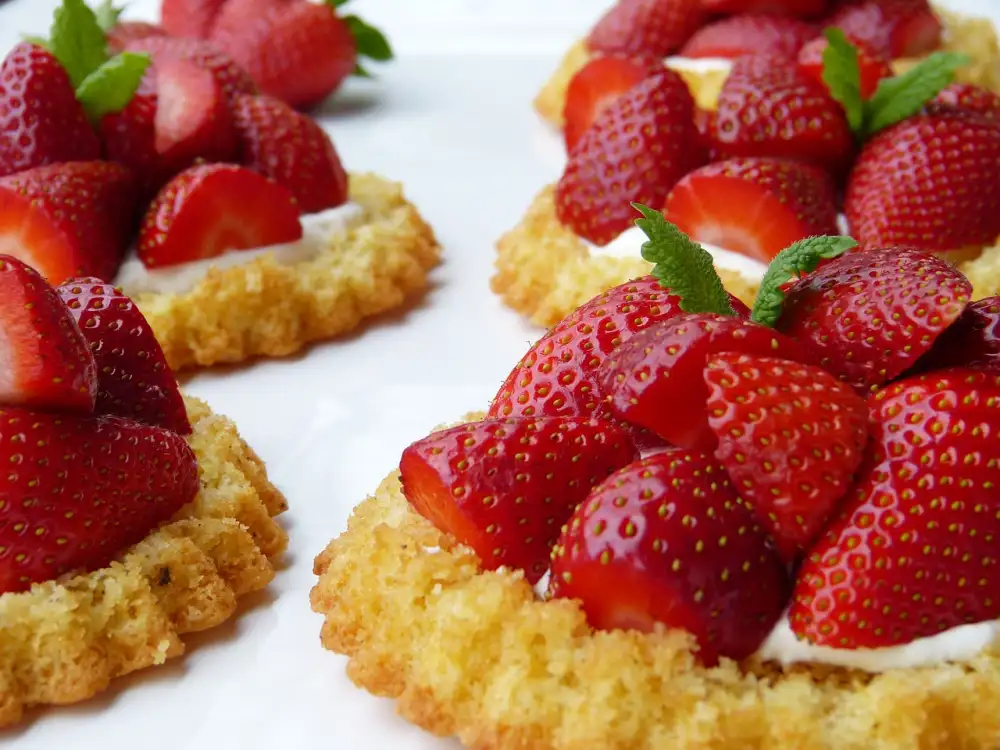Discover the Health Benefits of Gluten-Free Flour: A Guide to Nourishing Alternatives

- Understanding Gluten and its Impact on Health
- Benefits of Gluten-Free Flour for Individuals with Gluten Sensitivity or Celiac Disease
- Exploring Different Types of Gluten-Free Flours
- Tips for Baking with Gluten-Free Flour
- Incorporating Gluten-Free Flour into Everyday Cooking
- Addressing Common Concerns and Misconceptions about Gluten-Free Flour
Gluten-free flour has gained popularity in recent years as a healthy alternative for individuals with gluten sensitivity or celiac disease. Gluten, a protein found in wheat, barley, and rye, can cause digestive issues and other health problems for those who are intolerant to it. As a result, many people are turning to gluten-free flour as a way to enjoy their favorite dishes without the negative effects of gluten. In this article, we will explore the health benefits of gluten-free flour and provide tips on how to incorporate it into your cooking and baking routines. Whether you have a gluten intolerance or simply want to try something new, discovering the world of gluten-free flour can open up a whole new realm of culinary possibilities.
Understanding Gluten and its Impact on Health
Gluten is a protein found in wheat, barley, and rye. For individuals with gluten sensitivity or celiac disease, consuming gluten can lead to a range of health issues. When these individuals consume gluten, their immune system reacts by attacking the lining of the small intestine. This can cause symptoms such as abdominal pain, bloating, diarrhea, and fatigue.
Furthermore, celiac disease is an autoimmune disorder that can lead to long-term damage to the small intestine if left untreated. It is estimated that around 1% of the global population has celiac disease, while many more may have non-celiac gluten sensitivity.
Avoiding gluten is essential for those with gluten-related disorders to maintain good health. This means finding suitable alternatives to traditional wheat-based products. Gluten-free flour provides an excellent option for individuals who need to eliminate gluten from their diet without compromising on taste or nutrition.
By understanding the impact of gluten on health, individuals can make informed choices about their dietary needs and embrace the benefits of using gluten-free flour in their cooking and baking endeavors.
Benefits of Gluten-Free Flour for Individuals with Gluten Sensitivity or Celiac Disease
Individuals with gluten sensitivity or celiac disease can greatly benefit from using gluten-free flour. Gluten, a protein found in wheat, barley, and rye, can cause adverse reactions in those with these conditions. Symptoms may include digestive issues, skin problems, fatigue, and even damage to the small intestine.
By switching to gluten-free flour, individuals can avoid these negative effects and improve their overall health. Gluten-free flours are made from alternative grains such as rice, corn, quinoa, and almond. These flours are easier to digest and do not trigger the immune response that occurs with gluten consumption.
Moreover, gluten-free flour is often enriched with essential nutrients like iron, calcium, and fiber. This ensures that individuals with gluten sensitivity or celiac disease still receive the necessary nutrients for a balanced diet. Additionally, using gluten-free flour opens up a world of culinary possibilities by allowing individuals to enjoy a wide range of baked goods without sacrificing taste or texture.
In conclusion, for those with gluten sensitivity or celiac disease, opting for gluten-free flour is a game-changer. It provides an opportunity to enjoy delicious food while maintaining good health.
Exploring Different Types of Gluten-Free Flours
When it comes to gluten-free flours, there are plenty of options to choose from. Each type of flour has its own unique taste, texture, and nutritional profile. Here are some popular gluten-free flours that you can experiment with in your cooking and baking:
1. Almond Flour: Made from finely ground almonds, almond flour adds a rich, nutty flavor to baked goods. It is high in protein, healthy fats, and vitamin E.
2. Coconut Flour: Derived from dried coconut meat, coconut flour is high in fiber and low in carbohydrates. It lends a subtle sweetness to recipes and works well in both sweet and savory dishes.
3. Rice Flour: Made from finely milled rice grains, rice flour is versatile and widely available. It has a mild flavor and can be used as a substitute for all-purpose flour in many recipes.
4. Buckwheat Flour: Despite its name, buckwheat is not related to wheat and is naturally gluten-free. Buckwheat flour has a slightly earthy taste and is packed with nutrients like magnesium and B vitamins.
5. Quinoa Flour: Quinoa flour is made by grinding quinoa seeds into a fine powder. It has a slightly nutty flavor and is known for its high protein content.
6. Chickpea Flour: Also known as gram or besan flour, chickpea flour is made from ground chickpeas. It has a distinct flavor and works well in savory dishes like falafel or socca.
7. Potato Starch: Potato starch is derived from the starch of potatoes and has a neutral taste. It adds moisture to baked goods and can be used as a thickening agent in sauces or soups.
These are just a few examples of the wide variety of gluten-free flours available on the market today. Experimenting with different types of flours can help you discover new flavors and textures while enjoying the health benefits of gluten-free alternatives.
Tips for Baking with Gluten-Free Flour
1. Use a blend: Opt for a pre-made gluten-free flour blend, as it combines different flours to mimic the texture and taste of traditional wheat flour.
2. Add binders: Gluten-free flours lack the binding properties of gluten, so add xanthan gum or guar gum to improve the texture and prevent crumbling.
3. Increase moisture: Gluten-free flours tend to absorb more liquid than regular flour. Adjust your recipe by adding extra moisture, such as milk or yogurt, to prevent dryness.
4. Experiment with ratios: It may take some trial and error to find the right ratio of gluten-free flour to other ingredients in your recipes. Start with a 1:1 substitution and adjust as needed.
5. Mix well: Thoroughly mix the batter or dough to ensure that all ingredients are evenly distributed. This will help achieve a better texture in your baked goods.
6. Allow for longer baking time: Gluten-free baked goods often require more time in the oven due to their denser nature. Keep an eye on your treats and be prepared to extend the baking time if necessary.
7. Let it cool: Allow your gluten-free baked goods to cool completely before serving or handling. This will help them set properly and maintain their structure.
Remember, baking with gluten-free flour may require some practice and experimentation, but don't be discouraged! With time, you'll develop a knack for creating delicious gluten-free treats that everyone can enjoy.
Incorporating Gluten-Free Flour into Everyday Cooking
Once you have familiarized yourself with the different types of gluten-free flours available, it's time to start incorporating them into your everyday cooking. Here are a few tips to help you get started:
1. Experiment with recipes: Start by substituting regular flour with gluten-free flour in your favorite recipes. Whether it's pancakes, cookies, or bread, try different combinations until you find the perfect texture and taste.
2. Mix different flours: Don't limit yourself to just one type of gluten-free flour. Blend different flours like almond, rice, and tapioca to create a unique flavor profile and enhance the nutritional value of your dishes.
3. Use binders: Gluten-free flours lack the elasticity that gluten provides. To ensure your baked goods hold together well, add binders like xanthan gum or guar gum to your recipes.
4. Increase moisture: Gluten-free flours tend to absorb more liquid than regular flour. Adjust the amount of liquid in your recipes accordingly to prevent dryness and achieve a moist texture.
5. Be patient: Baking with gluten-free flour may require some trial and error before achieving desired results. Don't get discouraged if your first attempt doesn't turn out perfectly - practice makes perfect!
By incorporating gluten-free flour into your everyday cooking, you can enjoy a wide variety of delicious and nutritious meals while catering to any dietary restrictions or sensitivities you may have. So go ahead, get creative in the kitchen and embrace the health benefits that gluten-free flour has to offer!
Addressing Common Concerns and Misconceptions about Gluten-Free Flour
Despite the numerous health benefits of gluten-free flour, there are still some common concerns and misconceptions surrounding its use. One major concern is the taste and texture of baked goods made with gluten-free flour. Many people worry that they will be dry, crumbly, or lacking in flavor. However, with the right recipes and techniques, it is possible to achieve delicious and satisfying results.
Another misconception is that gluten-free flour is only suitable for individuals with gluten sensitivities or celiac disease. While it is true that those with these conditions must strictly avoid gluten, anyone can benefit from incorporating gluten-free flour into their diet. It offers a wider range of nutrients and can help diversify your culinary experiences.
Some individuals also believe that gluten-free flours are difficult to work with or require special skills to bake successfully. While it may take some experimentation and adjustments to familiarize yourself with different types of gluten-free flours, there are plenty of resources available to guide you through the process. With practice, you can become proficient in baking with these alternative flours.
It is important to note that not all gluten-free flours are created equal. Some may have a stronger flavor or denser texture than others. By exploring different types of gluten-free flours such as almond flour, coconut flour, or rice flour, you can find the ones that best suit your taste preferences and desired outcomes.
In conclusion, addressing common concerns and misconceptions about gluten-free flour is essential in order to fully embrace its health benefits. With proper knowledge and techniques, you can create delicious baked goods and incorporate this nourishing alternative into your everyday cooking routine. Don't let misconceptions hold you back from exploring the world of gluten-free flours - they offer a whole new realm of culinary delights waiting to be discovered!
As we have explored in this guide, gluten-free flour offers a range of health benefits for individuals with gluten sensitivity or celiac disease. By eliminating gluten from their diet and incorporating gluten-free flours, these individuals can enjoy delicious meals without compromising their health.
Not only does gluten-free flour provide a safe alternative for those with dietary restrictions, but it also offers various options to experiment with in the kitchen. From almond flour to quinoa flour, there are numerous types of gluten-free flours that can add unique flavors and textures to your dishes.
While baking with gluten-free flour may require some adjustments and experimentation, the end result is worth it. With a few tips and tricks, you can achieve delicious baked goods that are just as satisfying as their gluten-containing counterparts.
Moreover, incorporating gluten-free flour into everyday cooking opens up a world of possibilities. From thickening sauces to creating crispy coatings for fried foods, gluten-free flours can be used in a variety of ways to enhance the flavor and texture of your favorite dishes.
It's important to address common concerns and misconceptions about gluten-free flour. While some may believe that it lacks nutrients or tastes inferior to traditional wheat flour, this is not necessarily the case. Many gluten-free flours are packed with vitamins, minerals, and fiber, making them a nutritious choice for everyone.
In conclusion, embracing the health benefits of gluten-free flour allows individuals with dietary restrictions to enjoy a wide range of culinary delights while maintaining their well-being. So why not explore the world of gluten-free flours and embark on a journey towards nourishing alternatives? Your taste buds and your body will thank you!
Published: 23. 12. 2023
Category: Health



